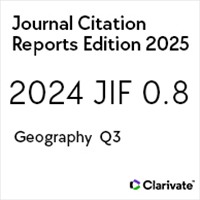Apertura comercial, relocalización espacial y salario regional en México
Trade openness, space relocation and regional salaries in México
https://doi.org/10.21670/ref.2010.21.a02
Palabras clave:
México, salarios, economías de aglomeración, relocalización espacial, apertura comercialResumen
El objetivo central de este documento es identificar las transformaciones ocupacionales entre ciudades, así como explorar si existen otros elementos relacionados con las características regionales, tales como economías de aglomeración y accesibilidad a los mercados, que influyan en las diferencias salariales entre ciudades. El aporte metodológico más relevante y que lo distingue de estudios previos en México es que para el análisis utiliza información a nivel de microdatos de trabajadores asalariados provenientes de la Encuesta Nacional de Empleo Urbano para el periodo 1992-2002 considerando 33 áreas urbanas. Los resultados de la investigación indican cambios en la distribución espacial de las actividades manufactureras; asimismo se encuentra evidencia de que las economías de aglomeración y la accesibilidad a los mercados tienen relevancia en la disparidad salarial en los años posteriores al Tratado de Libre Comercio de América del Norte, aunque su influencia es diferente por actividad.Abstract The central objective of this document is to identify the occupational transformations among cities, as well as to explore if other elements related to the regional characteristics exist, such as economies of agglomeration and accessibility to the markets, that influence in the wage differences among cities. The most relevant methodological contribution that distinguishes it of previous studies in México is that for the analysis uses information at level of micro data of wage-earning workers of the National Survey of Urban Employment used for the period 1992-2002 considering 33 urban areas. The results of this research indicate changes in the spatial distribution of the manufacturing activities. Also, it is evidence that the economies of agglomeration and accessibility to the markets they have relevance in the wage disparity in the later years to the Free Trade Agreement of North America, although its influences is different by activity.
Citas
Arrow, K. J. (1962), “Economic Welfare and the Allocation of Resources for Invention”, en R.R. Nelson (ed.), The Rate and Direction of Inventive Activity, Princeton, Princeton University Press, pp. 905-917. DOI: https://doi.org/10.1515/9781400879762-024
Castro (2007) “Disparidad salarial urbana en México, 1992-2002”, Estudios Sociales, vol. XV, pp. 118-153.
— (2006), “Curva salarial: una aplicación para el caso de México, 1993-2002”, Estudios Económicos, vol. 21, pp. 233-273.
Combes, P., G. Duranton y L. Gobillon (2004), Spatial Wage Disparities: Sorting Matters!, CERP Discussion Papers, 4240.
Duranton, G. y D. Puga (2001), “Nursery Cities: Urban Diversity, Process Innovation, and the Life-Cicle of Products”, American Economic Review, vol. 9, pp.1454-1477, DOI: https://doi.org/10.1257/aer.91.5.1454
Félix, G. (2004), “Apertura y ventajas territoriales: análisis del sector manufacturero en México, mimeo.
Gleaser, E. y Maré D. (2001), “Cities and Skills”, Journal of Labour Economics, vol. 19, núm. 2, pp. 316-342. DOI: https://doi.org/10.1086/319563
Gleaser E., D. Kallal, J. Scheinkman y A. Shleinfer (1992), “Growth in Citles”, Journal of Political Economy, vol. 100, pp. 1126-1152. DOI: https://doi.org/10.1086/261856
Gordo E., M. Gil y M. Pérez (2003), Los efectos de la integración económica sobre la especialización y distribución geográfica de la actividad industrial en los países de la UE; Banco de España, Documento ocasional, núm. 303.
Hanson G. (1998), “Regional Adjustment to Trade Liberalization”, Regional Science and Urban Economics, vol. 28, núm. 4 pp. 419-444. DOI: https://doi.org/10.1016/S0166-0462(98)00006-4
— (1997), “Increasing Returns, trade and the regional Structure of Wages” The Economic Journal, vol. 107, núm 440, pp. 113-133. DOI: https://doi.org/10.1111/1468-0297.00145
— (1996), “Localization Economics, Vertical Organization, and Trade”, The American Economic Review, vol. 86, núm. 5, pp. 1266-1278.
Head, K y T. Mayer (2004), “The Empirics of Agglomeration and Trade”, Handbook of Urban and Regional Economics, vol. 4, cap. 59, pp. 2609-2669. DOI: https://doi.org/10.1016/S1574-0080(04)80016-6
Herderson, J. V. (2003), “Marshall’s Scale Economies”, Journal of Urban Economics, vol. 53, núm. 1, pp. 1-28. DOI: https://doi.org/10.1016/S0094-1190(02)00505-3
— A. Kurcoro y M. Turner (1995), “Industrial Development of Cities”, Journal of Political Economy, Vol.103, núm. 5, pp. 1067-1090. DOI: https://doi.org/10.1086/262013
Jacobs, J. (1969), The Economy of Cities, Nueva York, Vintage Books.
Krugman, P. (1992), Geografía y comercio, Barcelona, Antoni Bosch Editor.
Krugman P. y Livas R. (1996) “Trade Policy and the Third World Metropolis”, Journal of Development Economics, vol. 49, pp. 137-150. DOI: https://doi.org/10.1016/0304-3878(95)00055-0
Marshall, A. (1920), Principles of Economics, Londres, MacMillan.
Mendoza E. y Martínez G. (1999) “Un modelo de externalidades para el crecimiento manufacturero regional”, Estudios Económicos, Vol.14, pp. 231-263.
Porter, M. (1990), The Competitive Advantage of Nations, Nueva York, Free Press. DOI: https://doi.org/10.1007/978-1-349-11336-1
Rauch, J. (1993), “Productivity Gains from Geographic Concentration of Human Capital: Evidence from de Cities”, Journal of Urban Economics, vol. 34, pp. 380-400. DOI: https://doi.org/10.1006/juec.1993.1042
Roback, J. (1982), “Wages, Rent and Quality of Live”, Journal of Political Economy, vol. 90, núm. 6, pp. 1257-1278. DOI: https://doi.org/10.1086/261120
Romer, P. (1986), “Increasing Returns and Long Run Growth”, Journal of Political Economy, vol. 94, núm. 5, pp. 1002-1037. DOI: https://doi.org/10.1086/261420
Rosenthal, S. y W. Strange (2004), “Evidence on the Nature and Sources of Agglomeration Economies”, Handbook of Urban and Regional Economics, vol. 4, cap. 49. DOI: https://doi.org/10.1016/S1574-0080(04)80006-3
— y W. Strange (2003), “Geography, Industrial Organization, and Agglomeration”, Review of Economics and Statistics, vol. 85, pp. 377-393. DOI: https://doi.org/10.1162/003465303765299882
Sanromá, E. y R. Ramos (2002), “La naturaleza de las economías externas territoriales y su influencia sobre los salarios. Un análisis para el caso español", en Desarrollo local: teoría y estrategias, Barcelona, Civitas.
Wheaton, W. y M. Lewis (2002), “Urban Wage and Labor Market Agglomeration”, Journal of Urban Economics, vol. 51, núm. 3. pp. 542-562. DOI: https://doi.org/10.1006/juec.2001.2257































